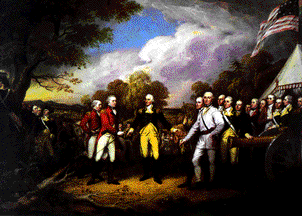By spring of 1777, the British knew they had to something fast to keep control of the colonies. Lord George Germain was a strategist for the British. He thought the British troops in Canada under Major General John Burgoyne needed to take control of Albany, New York and the Hudson River. This would divide the New England colonies from all the other colonies at the Hudson River and make it easier for Britain to gain control.
Major General Burgoyne with 6,000 men left Montreal, Quebec in Canada in June 1777. When they went through Northern New York, they stopped at Fort Ticonderoga and took that fort over from the Americans.
The First
Battle of Saratoga (Freeman's Farm)
When Major General Burgoyne
and his men reached Albany in September, they found the city protected
by 7,000 Patriots under Major General Horatio Gates. Because the
Patriots had used the land to their advantage, they decided to
sit and let the British make their move. There were some minor
assaults, but finally on September 19, 1777, Major General Burgoyne
and his troops attacked the Patriots at Freeman's Farm. The Patriots
were reinforced by Major General Benedict Arnold's troops, but
could not hold off the British.
The Patriots, who had 320 men killed or wounded, retreated to Bemis Heights. There were 600 British killed or wounded, and the survivors moved two miles north of Freeman's Farm where they set up their camp headquarters. The British continued their assaults on the Patriots.
The Second
Battle of Saratoga (Bemis Heights)
On October 7, 1777 Major
General Burgoyne and his men staged a full assault on the Patriots
at Bemis Heights. The Patriots had let the British wear themselves
down with all their minor assaults and were ready for them on
October 7th. The Patriot defense was made up of Major General
Gates', Major General Arnold's, and Major General Daniel Morgan's
troops. They were a strong defense against the British assault.
Major General Burgoyne's men had no choice but to retreat to Saratoga (which is now known as Schuylerville). They had suffered 600 losses compared to the Patriot loss of only 150 men. On October 17, 1777, Major General Burgoyne with less than 5,000 men surrendered to a Patriot Army of 20,000 men. (Some sources said that the 5,000 men who surrendered were one-fourth of the entire British Army in the Colonies.)

The Battles of Saratoga were a major turning point in the war. The British goal of taking control of the North died and they were forced to give up hope of ever regaining full authority over the northern Colonies. The French decided then to join the Patriots in the war against the British, and they were part of the victory at Yorktown, where General Cornwallis' troops also surrendered. And probably more importantly, the Patriots themselves knew they had gained control of the northern Colonies which gave them more confidence and reason to continue fighting.
There were still many battles that would be fought before the Colonies really won their independence from British rule, but this Patriot victory was a big turning point in the Revolutionary War.
| "But there is more then the military significance, the immediate significance of the time. It is here that every American can stand and truthfully say, Had General Gates not beaten Burgoyne on this spot, I might not be an American today." It was at Concord, Independence Hall, Trenton, Yorktown and Saratoga that this Nation was assured its life. The flickering light for freedom was strengthened here and a Nation based on some of the most liberal and selfless principles of all time was assured an existence. Without this battle, without the existence of Bemis Heights with the river running close by, this Nation may never have existed. This is the real significance of Saratoga." |




